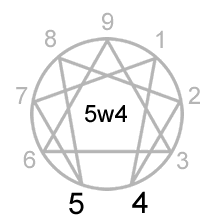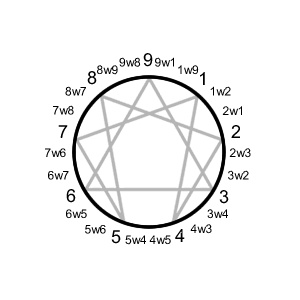Enneagram Type 5 Wings: 5w4 and 5w6
The core focus of Enneagram type 5

A man should look for what is, and not for what he thinks should be.
- Albert Einstein
Early in life we develop an initial belief about ourselves and a compensation for that self-belief.
-
Type 5 Initial Self-Belief: “I am uninformed as I am.”
Type 5 Compensation: "I must objectively observe the world as it is in order to clearly make sense of and navigate it."
Over time this gets generalized beyond the self into a core focus that also shapes how we perceive and interact with the world at large.
-
Type 5 Core Focus: Comprehension comes from objectively observing the world and logically distilling the facts. This often requires that I detach from experiences as they happen in order to see things clearly and not feel overwhelmed. I need time and space to later process those facts and experiences.
Personality characteristics that might arise from the type 5 core focus include:
- Narrows area of interest to specialized niche
- Minimizes needs to avoid dependency on others
- Guards against intrusions upon privacy
- Lives life from the sidelines instead of fully participating
- Withdraws when feeling overwhelmed by people
- Postpones action in favor of more research and analysis
- Detaches from emotions by going into the head
- Delays experiencing life in the moment, rehashing it when alone
- Requires time to think and reflect before responding
The wings of Enneagram type 5

The wings are represented by the numbers on either side of a given type as seen on the Enneagram symbol or diagram. These types are said to have an additional influence upon the type being looked at. The wing types for type 5 are type 4 and type 6.
Although type 5 is influenced by both wings, an individual will generally be influenced more by one of the wings than the other. The wing with more influence is said to be the preferred or dominant wing.
-
5 wing 4 (5w4) - preferred 4 wing
Common Name: The Iconoclast- more imaginative than analytic
- deals more with symbolic representation
- more peaceful and going along
-
5 wing 6 (5w6) - preferred 6 wing
Common Name: The Problem-Solver- more technically oriented
- deals more with factual details
- more contrary and argumentative
What Enneagram authors say about 5w4 and 5w6


Below are samplings from some popular or well-known Enneagram authors. Click on the sources after the descriptions to further explore these interpretations.
-
The Five with a Four-Wing: The Iconoclast
Often drawn to the arts, they use the imagination more than the analytic, systematic parts of their minds. Their interests tend toward the surreal and fantastic rather than the rational or the romantic: they can easily get lost in their own cerebral landscapes.1The Five with a Six-Wing: The Problem-Solver
Observation combined with organization and detail gives people of this subtype the ability to draw meaningful conclusions from miscellaneuous facts and to make predictions based on those conclusions. They can be more argumentative than the other subtype and more defensive in their views.1 -
Five with a Four Wing (5w4): These more inward-looking Fives bring subjective awareness to their process of analysis and discovery. They may enjoy the overtly bizarre.2
Five with a Six Wing (5w6): These more outward-looking Fives bring rigorous, process-oriented thinking to their analytic methods. They may prefer systematizing or hands-on means.2
-
Fives with a Four wing may be more emotional and artistic.3
Fives with a Six wing may be more skeptical and cautious.3
-
Enneagram Type 5w4 by Ian Morgan Cron
Enneagram Type 5w6 by Ian Morgan Cron
Fives with a Four wing (5w4) are more creative, sensitive, empathetic and self-absorbed than 5w6s. The connection to Four’s energy and depth of emotion helps these Fives be more tender with themselves and less emotionally guarded around others.4
Five with a Six wing (5w6) are more anxious, cautious and skeptical, but they’re also more social and loyal than 5w4. Fives with six wings live more in their minds and will question authority and the status quo.4
-
Fives with a more developed Four wing tend to be more creative, humanistic, sensitive, empathic, and self-absorbed.5
Fives with a more developed Six wing tend to be more loyal, anxious, skeptical, and cautious.5
-
Five With a 4 Wing
The difference between the 4 wing and the 6 wing in Fives is like the difference between Art and Science. 4 wing brings an abstract, intuitive cast of thought, as though the Five were thinking in geometric shapes instead of words or realistic images.6Five With a 6 Wing
The 6 wing brings an orientation to detail and technical knowledge, along with the tendency to think in logical sequence. Especially intellectual, far more analytical than Fives with a 4 wing.6
Sources
1Book: The Wisdom of the Enneagram
2Book: The Modern Enneagram
4Book: The Road Back to You
5Book: The Enneagram Made Easy
To learn more about the basic type 5 or one of the wing types click on a link below.
Enneagram Tests to Help Determine Wing

The wing types of an Enneagram type are the types on either side of a type as seen on the Enneagram symbol.
Although both the wing types have an influence on the type between them, one wing type is often preferred over the other.
This preferred wing type has a stronger influence than the non-preferred wing type and creates a variation of the type (e.g., 9w8 vs. 9w1).
-
Enneagram Type with Wing Test
This is a very short test that determines your most likely type and preferred wing.
Select from paragraphs, similar to the method used by the
Essential Enneagram Test as found in The Essential Enneagram book.
Use when you want to know your type and preferred wing. -
Enneagram Type Preference Test
This test produces a scored list of all nine types.
Questions are forced-choice, similar to the method used by the Riso-Hudson Enneagram Type Indictor (RHETI).
Use to determine type, wings, gut/heart/head types, and tri-center. -
Enneagram Wing Comparison Test
This test compares the two wings of any type, producing a score for each wing.
Use when you know your type but not your preferred wing. -
Enneagram Type Comparison Test
This test compares any two types, producing a score for each.
Use when not sure which of two types is your primary type and which is your preferred wing type.
Click here for the Complete Guide to the Enneagram.
This free guide explains- the nine Enneagram personality types
- the many type variations within type
- where the types came from (origins and history)
- how the types use the Enneagram symbol
Click here for Enneagram tests.
These free tests help you find your- primary type
- candidate types
- preferred wing
- intinctual subtype
- instinctual variant stacking
- center types (gut, heart, and head)
- tri-center with wings